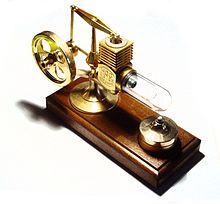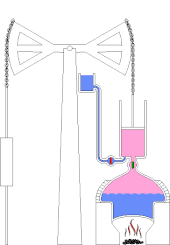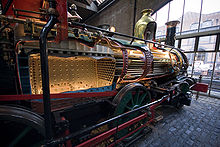


| Part of a series on |
| Aircraft propulsion |
|---|
|
Shaft engines: driving propellers, rotors, ducted fans or propfans |
| Reaction engines |
An external combustion engine (EC engine) is a reciprocating heat engine where a working fluid, contained internally, is heated by combustion in an external source, through the engine wall or a heat exchanger. The fluid then, by expanding and acting on the mechanism of the engine, produces motion and usable work. The fluid is then dumped (open cycle), or cooled, compressed and reused (closed cycle). In these types of engines, the combustion is primarily used as a heat source, and the engine can work equally well with other types of heat sources.
Combustion
"Combustion" refers to burning fuel with an oxidizer, to supply the heat. Engines of similar (or even identical) configuration and operation may use a supply of heat from other sources such as nuclear, solar, geothermal or exothermic reactions not involving combustion; they are not then strictly classed as external combustion engines, but as external thermal engines.
Working fluid
The working fluid can be of any composition and the system may be single-phase (liquid only or gas only) or dual-phase (liquid/gas).
Single phase
Gas is used in a Stirling engine. Single-phase liquid may sometimes be used.
Dual phase
Dual-phase external combustion engines use a phase transition to convert temperature to usable work, for example from liquid to (generally much larger) gas. This type of engine follows variants of the Rankine cycle. Steam engines are a common example of dual-phase engines. Another example is engines that use the Organic Rankine cycle.
See also
- Organic Rankine cycle
- Steam engines
- Stirling engines
- Trochilic engine
- Internal combustion engine (ICE)
- Nuclear power
- Solar thermal rocket (an externally heated rocket)
- Naptha engine, a variant of the steam engine, using a petroleum liquid as both fuel and working fluid.
References
| Thermodynamic cycles | |||||
|---|---|---|---|---|---|
| External combustion / thermal |
| ||||
| Internal combustion / thermal | |||||
| Mixed | |||||
| Refrigeration | |||||
| Machines | |
|---|---|
| Classical simple machines | |
| Clocks | |
| Compressors and pumps | |
| External combustion engines | |
| Internal combustion engines | |
| Linkages | |
| Turbine | |
| Aerofoil | |
| Electronics | |
| Vehicles | |
| Miscellaneous | |
| Springs | |